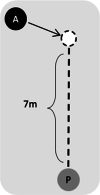Virtual reality-based assessment of cognitive-locomotor interference in healthy young adults
- PMID: 33752704
- PMCID: PMC7983256
- DOI: 10.1186/s12984-021-00834-2
Virtual reality-based assessment of cognitive-locomotor interference in healthy young adults
Abstract
Background: A recent literature review emphasized the importance of assessing dual-task (DT) abilities with tasks that are representative of community ambulation. Assessing DT ability in real-life activities using standardized protocols remains difficult. Virtual reality (VR) may represent an interesting alternative enabling the exposure to different scenarios simulating community walking. To better understand dual-task abilities in everyday life activities, the aims of this study were (1) to assess locomotor and cognitive dual-task cost (DTC) during representative daily living activities, using VR, in healthy adults; and 2) to explore the influence of the nature and complexity of locomotor and cognitive tasks on DTC.
Methods: Fifteen healthy young adults (24.9 ± 2.7 years old, 8 women) were recruited to walk in a virtual 100 m shopping mall corridor, while remembering a 5-item list (DT condition), using an omnidirectional platform and a VR headset. Two levels of difficulty were proposed for the locomotor task (with vs. without virtual agent avoidance) and for the cognitive task (with vs. without items modification). These tasks were also performed in single task (ST) condition. Locomotor and cognitive DTC were measured by comparing performances in ST and DT conditions. Locomotor performance was characterized using walking speed, walking fluidity, and minimal distance between the participant and the virtual agent during avoidance. Cognitive performance was assessed with the number of items correctly recalled. Presence of DTC were determined with one-sample Wilcoxon signed-rank tests. To explore the influence of the tasks' complexity and nature on DTC, a nonparametric two-way repeated measure ANOVA was performed.
Results: No locomotor interference was measured for any of the outcomes. A cognitive DTC of 6.67% was measured (p = .017) while participants performed simultaneously both complex locomotor and cognitive tasks. A significant interaction between locomotor task complexity and cognitive task nature (p = .002) was identified on cognitive DTC.
Conclusions: In challenging locomotor and cognitive conditions, healthy young adults present DTC in cognitive accuracy, which was influenced by the locomotor task complexity task and the cognitive task nature. A similar VR-based protocol might be used to investigate DT abilities in older adults and individuals with a stroke.
Keywords: Cognition; Dual‐task cost; Healthy adults; Locomotion; Virtual reality.
Conflict of interest statement
The authors declare that they have no competing interests.
Figures


Similar articles
-
Exploring the challenges of avoiding collisions with virtual pedestrians using a dual-task paradigm in individuals with chronic moderate to severe traumatic brain injury.J Neuroeng Rehabil. 2024 May 16;21(1):80. doi: 10.1186/s12984-024-01378-x. J Neuroeng Rehabil. 2024. PMID: 38755606 Free PMC article.
-
Dual-Task Abilities During Activities Representative of Daily Life in Community-Dwelling Stroke Survivors: A Pilot Study.Front Neurol. 2022 May 3;13:855226. doi: 10.3389/fneur.2022.855226. eCollection 2022. Front Neurol. 2022. PMID: 35592466 Free PMC article.
-
Age-Related Effects on Cognitive-Locomotor Dual-Task Abilities in Activities Representative of Daily Life Among Young Seniors.Percept Mot Skills. 2025 Apr 11:315125251332325. doi: 10.1177/00315125251332325. Online ahead of print. Percept Mot Skills. 2025. PMID: 40215452
-
Cognitive-Locomotor Dual-Task Interference in Stroke Survivors and the Influence of the Tasks: A Systematic Review.Front Neurol. 2020 Aug 18;11:882. doi: 10.3389/fneur.2020.00882. eCollection 2020. Front Neurol. 2020. PMID: 33013625 Free PMC article.
-
The Immersive Cleveland Clinic Virtual Reality Shopping Platform for the Assessment of Instrumental Activities of Daily Living.J Vis Exp. 2022 Jul 28;(185). doi: 10.3791/63978. J Vis Exp. 2022. PMID: 35969104 Review.
Cited by
-
Comparing episodic memory outcomes from walking augmented reality and stationary virtual reality encoding experiences.Sci Rep. 2024 Mar 30;14(1):7580. doi: 10.1038/s41598-024-57668-w. Sci Rep. 2024. PMID: 38555291 Free PMC article.
-
Impact of dual tasking on gaze behaviour and locomotor strategies adopted while circumventing virtual pedestrians during a collision avoidance task.Exp Brain Res. 2022 Oct;240(10):2633-2645. doi: 10.1007/s00221-022-06427-2. Epub 2022 Aug 18. Exp Brain Res. 2022. PMID: 35980438
-
A New Paradigm for the Study of Cognitive Flexibility in Children and Adolescents: The "Virtual House Locomotor Maze" (VHLM).Front Psychiatry. 2021 Sep 23;12:708378. doi: 10.3389/fpsyt.2021.708378. eCollection 2021. Front Psychiatry. 2021. PMID: 34630176 Free PMC article.
-
The Untapped Potential of Virtual Reality in Rehabilitation of Balance and Gait in Neurological Disorders.Front Virtual Real. 2021 Mar;2:641650. doi: 10.3389/frvir.2021.641650. Epub 2021 Mar 11. Front Virtual Real. 2021. PMID: 33860281 Free PMC article.
-
Exploring the challenges of avoiding collisions with virtual pedestrians using a dual-task paradigm in individuals with chronic moderate to severe traumatic brain injury.J Neuroeng Rehabil. 2024 May 16;21(1):80. doi: 10.1186/s12984-024-01378-x. J Neuroeng Rehabil. 2024. PMID: 38755606 Free PMC article.
References
Publication types
MeSH terms
LinkOut - more resources
Full Text Sources
Other Literature Sources

